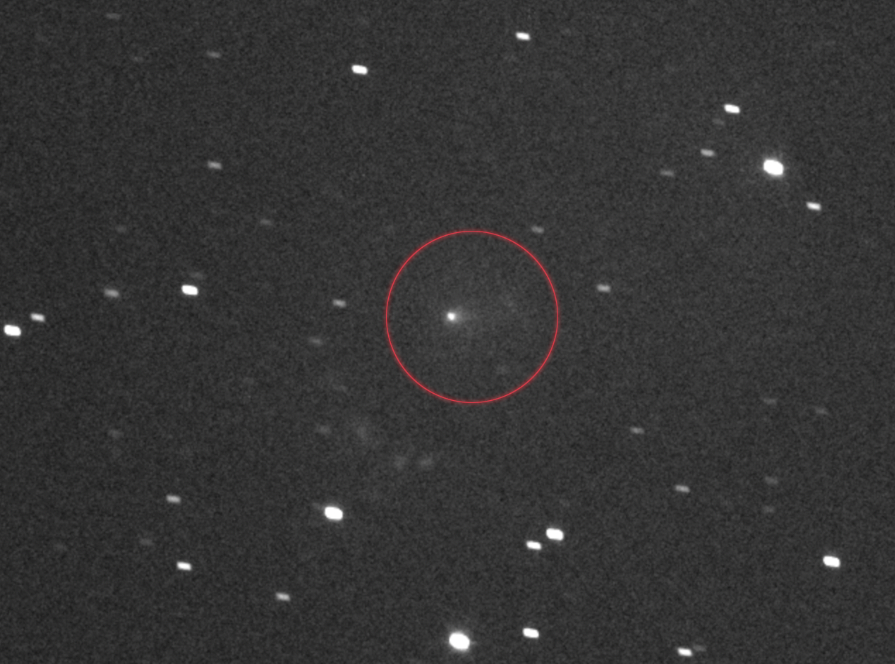NASA releases new high-res images of 3I/ATLAS after government shutdown delay

Around Oct. 30, the mysterious out-of-this-world 3I/ATLAS reached its closest point in the solar system, roughly 130 million miles away from the Sun.
Despite that vast distance, experts in NASA’s Planetary Defense Coordination Office established “right away” that the unusual object was an interstellar comet that did not present a danger for humans on Earth, senior officials said this week.
“In fact, it’s at least twice as far away as the distance between the Earth and our Sun,” Associate Administrator of NASA’s Science Mission Directorate Nicky Fox explained.
During a virtual event on Wednesday, she and other senior officials released new and long-awaited images of 3I/ATLAS that were processed or taken by spacecraft between late September through October. Some of the high-res imagery shows a small, glowing orb with a fuzzy shadow trailing behind it.
“We were quick to be able to say, ‘Yep, it definitely behaves like a comet.’ We certainly haven’t seen any techno-signatures or anything from it that would lead us to believe it was anything other than a comet. But the super cool thing is not that it’s exactly like all the comets that we see in our solar system. It’s the differences that are so tantalizing,” Fox said. “It could be from something that existed before our own solar system — that is so cool. It’s from something that predates even our own star. Yep, it’s going to look different because it didn’t come from our solar system, and that’s what makes it so magical. You want to geek out a little bit.”
The U.S. government has grappled with questions about the nature and origin of the interstellar comet and its baffling trajectory since it was first spotted in July by NASA’s Asteroid Terrestrial-impact Last Alert System (ATLAS) telescope in Chile.
But inquiries and concerns intensified when the space agency delayed its public data and imagery dissemination amid the record-breaking government shutdown that stretched from Oct. 1 to mid-November.

(Image credit: NASA/Goddard/SwRI/JHU-APL)
“I’m actually very excited that a lot of the world was speculating about the comet while NASA was in a period where we couldn’t speak about it due to the recent government shutdown,” the agency’s Associate Administrator Amit Kshatriya said. “What I took away from that whole experience, and watching that as we were working during the shutdown, was just how interested and how excited people were about the possibility of what this comet could be.”
NASA’s assets that are conducting observations of 3I/ATLAS include: Hubble, Webb, TESS, Swift, SPHEREx, Perseverance Mars rover, MRO (Mars Reconnaissance Orbiter), MAVEN (Mars Atmosphere and Volatile EvolutioN), Europa Clipper, Lucy, Psyche, Parker Solar Probe, PUNCH, and ESA/NASA’s SOHO.
“And we’re still going — there will be more opportunities to observe this comet as it continues its journey through the solar system, passing the orbit of Jupiter in spring of 2026,” Fox said at Wednesday’s post-shutdown briefing.
On Thursday, NASA’s Acting Planetary Defense Officer Kelly Fast told DefenseScoop that — although 3I/ATLAS is only the third interstellar object of its kind to be recorded — her team expects to see upward trends in these rare objects being reported in the years to come.
“As more advanced ground-based capabilities come into play, and once NASA’s Near-Earth Object Surveyor mission launches, it is anticipated astronomers may discover more of the population of interstellar objects passing through our solar system,” Fast explained.
Notably, NASA works with the Pentagon’s All-domain Anomaly Resolution Office (AARO), which was set up in recent years to investigate airborne, transmedium and submerged objects and devices that are not immediately identifiable, but could impact U.S. national security.
Formerly called UFOs, these perplexing objects are referred to in the modern era as UAP.
Earlier this month, a Pentagon official told DefenseScoop that AARO was following 3I/ATLAS closely. However, they said the team was not supplying NASA with assistance at that time because the effort “falls outside of AARO’s mission as the object is assessed to be a comet and therefore is not considered [UAP].”
Fast did not reveal details about how AARO assists the space agency in cases where new and puzzling objects like 3I/ATLAS emerge, in response to questions from DefenseScoop following Wednesday’s briefing.
Instead, she spotlighted NASA’s process for determining whether the entities are UAP, interstellar comets, or something else.
The Planetary Defense Coordination Office funds the Minor Planet Center (MPC), which is the internationally recognized clearing house for known natural object position data and has responsibility for identification and designation of natural objects, according to Fast. Shortly after 3I/ATLAS was first observed by NASA, experts reported position data to the MPC.
“That data — along with additional position observations from around the world and reported cometary activity — identified it as a newly discovered object on an interstellar trajectory and designated it as comet C/2025 N1 (ATLAS) or interstellar object 3I/ATLAS,” Fast said.
When new objects are first discovered, NASA’s Center for Near-Earth Object Studies (CNEOS) at the agency’s Jet Propulsion Laboratory calculates precision trajectories of objects reported to the MPC to determine if they present threats to Earth.
“After 3I/ATLAS’s discovery, CNEOS used the position measurement data submitted to the MPC by ground-based observatories to determine it would not approach Earth and was not considered an impact hazard,” Fast told DefenseScoop.



